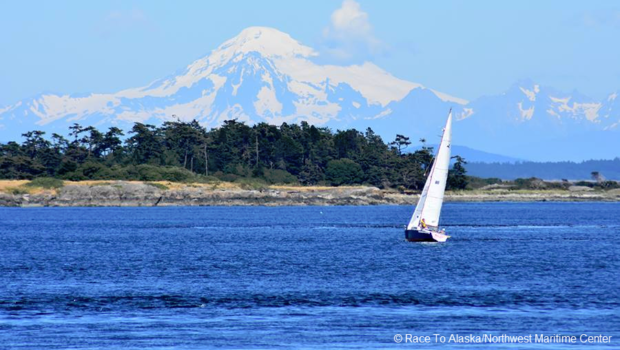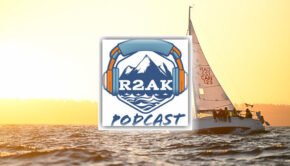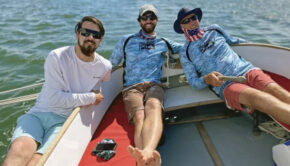R2AK: The Adventure Gets Real
Published on June 26th, 2016
The Race to Alaska (R2K) is a unique 750-mile marathon open to all forms of non-motorized craft. Entrants can have no support of any type; it’s like the Iditarod but on a boat. Avoid drowning, freighters, killer whales, and grizzly bears, and the winner gets $10,000. A set of steak knives awaits the runner-up.
It is a two stage event, with the first stage from Port Townsend, WA to Victoria BC as a 40 mile qualifier before entrants can start the 710 stage from Victoria BC to Ketchikan, AK on June 26. Here is an update from day one of stage two:
The docks in Victoria were alive with expectation and goodbyes. Fans and families came out in force to get one last look at their teams, one last hug, another last hug, wish good luck, and just stand in proximity for one last important and awkward moment before the docks were cleared and racers moved to the head of the seawall to stand under Captain Cook’s sternly skeptical bronze gaze.
A hundred some racers stretched, took some selfies, shook hands with one of R2AK 2015’s Team Soggy Beavers who showed up to offer encouragement and get as close to the action as his envy would allow (“I’ve got so much FOMO right now!”). Thirty-eight teams, for various reasons, were now Alaska-bound.
The sequence was counted down on a ship’s bell borrowed from the Maritime Museum and a megaphone “lent” to the race by the Canadian Government. Five minutes, four, three, two, one—the bell rang, the megaphone yelled, a thousand onlookers cheered, a thousand more wondered what the hell was going on, the regular cast of street performers waited patiently (almost) to set up their regularly schedule juggling, and crews flowed fast down both sets of steps in a symmetrical human cascade.
Sprinting to their boats, casting off, and madly pedaling, rowing, and paddling to start the race by escaping a harbor where sailing is against the law. Oars and paddles frothed the water, and the small and nimbler shot ahead and got to lead the pack even if just for an instant and the honest claim to a bar brag.
Clearing the breakwater teams hoisted sails and stemmed the tide on a light northerly, and as they fought clear of the currents of Trial Island, they made the first big decision of the race: add miles and hopefully hang in the wind of Haro Strait and Boundary Pass or gamble it on the intricacies of the Gulf Islands, hoping that the eddies and thermals of the archipelago would trump mixing it up with willing foes and sea room.
Team Kraken Up’s largely human powered effort made a different choice. After charging down the dock with everyone else, they made lunch and waited for the tide to run in their favor. This will be a long race and no need to exhaust themselves with the water against them at 50% of their top speed. The water moved fast, so lunch moved faster.
To the surprise of no one, Team MAD Dog Racing’ M32 slipped the leash and ran rabid out ahead of the pack—making upwards of 12 knots in roughly the same amount of wind while the Farrier fleet followed local knowledge across the border and back again.
The trimaran mob hunted wind from from beach to beach while Team Angus Adventures could be seen hugging the Canadian shore, autopilot on and reading a book that might as well been the instruction manual of how to get to Alaska without appearing to try.
Others let us know that they were making changes, some were serious, some less so. One team informed us of their plans to change their team name to Mail Order Bread—and if not this year, the next. Next year would give them enough time to start up an internet company with the same name that would specialize in remote gluten fulfillment—that way they could be sponsored and afford a bigger boat. Form following function and planning ahead, or a team that has already spent too long in the sun? Only time will tell, but just in case please drink water and put on a hat.
The day’s shocker was Team Tritium Racing’s exit from the R2AK. They looked at the coming weather, looked at their odds, and retired from the race within sight of the starting line. No scandal, no damage, just took their toys and went home.
It was surprising. They put in a metric ton of work to get one, then a second boat ready to race after their first was damaged beyond repair, assembled, then reassembled a crew with some of the hottest shots on both coasts. They even got into the spirit and clambered through the polished doors of Victoria’s stately Empress Hotel and had high tea in their drysuits. Hilarious!
While it’s hard to understand why a team would round trip 3,000 road miles to race for just 40 miles on the water, their departure was the final act of a boogie man that started to vanish nearly as soon it appeared.
At one point their original bid was the race’s front page headline, in multiple papers, a jaw-dropper. They were the 73-foot trimaran with an all-pro crew that was going to make records and indelibly change the R2AK’s everyman ethos. At least that’s what people told us. But with every pre-race repair, stilted delivery, boat change and eventual departure, the headline moved below the fold, became a footnote, a shoulder shrug, a remember when.
By the numbers, their F32 and crew that hit the starting line were a threat, but as much as it is a forum for skill and speed, the R2AK was designed to test resolve and reward resilience, and today they made the choice to turn right and go home. Heart wasn’t in it. Maybe another year.
As Team Tritium sails home, and the rest of the fleet races on into the false metaphor of a breathtaking sunset, the stories of resolve loom perhaps even larger than the mad dash of Team MAD Dog Racing who at time of writing have horizoned the fleet and are on pace to hit Seymour Narrows in record time.
Our favorites on Team Alula – Bruno, Zach and Spike – asking for no quarter despite not having functional legs. When asked if the start could be changed to accommodate them, they were adamant and took the two flights of stairs like everyone else, but like no one else, and amazed everyone with their spirit and resolve as these smiling wheelchaired warriors bombed down the stairs and rolled themselves to their boat unassisted. Wheeled down the stairs. Incredible.
Or how about Karl Kruger, the lone standing soul onboard Team Heart of Gold’s bid to be the first paddleboarder to transit the Inside Passage in this direction? By mid-afternoon he was mid-pack, miles ahead of any other solo team, and had paddled his way in front of some of the faster boats in the fleet. Incredible. Not bad for a guy whose sole subsistence is food replacement pellets, three an hour in order to meet his caloric goal. By nightfall he and Colin Angus appeared to be sharing a campsite and waiting for the tide.
The light winds of today are predicted to give way to the stronger tomorrow, and 35 knots in the Johnstone Strait: a nasty patch of water that will test resolve, standing rigging, and the ability to hold down breakfast. Despite big leads, this is still anyone’s race and favor has proven to be fickle. Stay tuned, anything could happen.
Event details – Facebook – Twitter – Stage 1 tracker – Stage 2 tracker
Source: Race to Alaska
Background:
Stage 1: Port Townsend, WA to Victoria BC (40 miles)
It all begins June 23 with an initial race across open water, two sets of shipping lanes, and an international border. The first stage is designed as a qualifier for the full race and as a stand-alone 40 mile sprint for people who just want to put their toe in. Racers continuing on will clear Canadian customs in Victoria. Stage one winners get to bask in the glory for a full day and a half.
Stage 2: Victoria BC to Ketchikan, AK (710 miles)
There’s no time splits from the qualifier that roll over when the fleet starts in Victoria on June 26. The race for the prizes – real or imagined – is getting to Ketchikan. For those that lag, they risk getting tapped out by the sweep boat which heads north along the course as a rolling disqualifier. Any competitor the sweep boat passes is out of the race. Other than two waypoints at Seymour Narrows and Bella Bella, there is no official course. To quote the bard: You can go your own way.
Winner: The 2015 race was won by Team Elsie Piddock – Al Hughes, Graeme Esarey, and Matt Steverson – that crushed the fleet in a F-25c, completing Stage 2 in 5 days, 1 hour, 55 minutes. They finished almost 40 hours ahead of the second place finisher Team MOB Mentality (F85SR, a 28′ Farrier “Super Racer”) which just edged by 4 minutes third place finisher Team Por Favor (Hobie 33).







 We’ll keep your information safe.
We’ll keep your information safe.